AP news story with comments by Joseph D’Aleo and Dr. Richard Keen Updated November 4, 2009
The snows of Kilimanjaro may soon be gone. The African mountain’s white peak made famous by writer Ernest Hemingway is rapidly melting, researchers report.
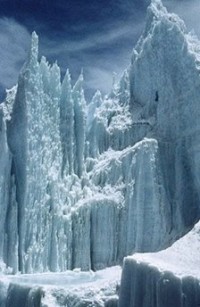
Some 85 percent of the ice that made up the mountaintop glaciers in 1912 was gone by 2007, researchers led by paleoclimatologist Lonnie Thompson of Ohio State University report in Tuesday’s edition of Proceedings of the National Academy of Sciences.
And more than a quarter of the ice present in 2000 was gone by 2007. If current conditions continue “the ice fields atop Kilimanjaro will not endure,” the researchers said. The Kilimanjaro glaciers are both shrinking, as the ice at their edges melts, and thinning, the researchers found.
Similar changes are being reported at Mount Kenya and the Rwenzori Mountains in Africa and at glaciers in South America (wrong see graph from Masiokas et al. 2006 below and enlarged here for Andes) and the Himalayas (also wrong - see comments on Thompson’s work by Madhav Khandekar here).
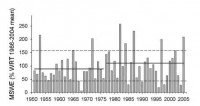
“The fact that so many glaciers throughout the tropics and subtropics are showing similar responses suggests an underlying common cause,” Thompson said in a statement. “The increase of Earth’s near surface temperatures, coupled with even greater increases in the mid- to upper-tropical troposphere, as documented in recent decades, would at least partially explain” the observations. ( Icecap Note: This is not true. Satellites and weather balloons show no warming in mid to high levels in the tropics. Only in the tinkertoy climate models does that happen but to alarmists that is reality. See John Christy plot of tropical temperatures in mid to high atmosphere from satellite below and enlarged here.).

Changes in cloudiness and snowfall may also be involved, though they appear less important, according to the study. (Once again wrong. Thompson sees what he wants to see in the data. But temperatures below and enlarged here have declined at Kilimanjaro not risen and precipitation below and enlarged here has declined due to deforestation and Atlantic Multidecadal changes. Also dust from drier ground is said to be darkening the ice and enhancing the melt.)
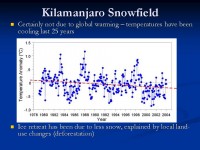
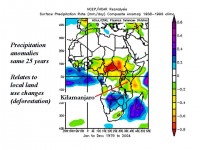
On Kilimanjaro, the researchers said, the northern ice field thinned by 6.2 feet (1.9 meters) and the southern ice field by 16.7 feet (5.1 meters) between 2000 and 2007. Researchers compared the current area covered by the glaciers with maps of the glaciers based on photographs taken in 1912 and 1953 and satellite images from 1976 and 1989. The ‘research’ was funded by the U.S. National Science Foundation and National Oceanic and Atmospheric Administration.
See story timed for Copenhagen by AP here.
Some very interesting additional thoughts and data from Dr. Richard Keen, the University of Colorado.
Ever since I climbed the “shining mountain” 27 years ago I’ve had a deep interest in it, and still keep tabs on the status of Kili’s ice cap. This year another estimate of the ice cap’s area appeared in the literature, and once again I’ve updated my graph.

Data from: USGS “Earthshots”:
The 2005 estimate is from Torbick et al., ”Changing Surface Conditions at Kilimanjaro Indicated from Multiscale Imagery”.
Note that the 2005 estimate shows an increase since 2003. I suspect that this increase is not real, but shows the uncertainties of estimating glacier areas from satellite. In any event, the recent measurements do show that the ice loss rate has decreased or even stopped. After 2000, Thompson’s data was linearly extrapolated to predict the glaciers’ complete demise in 2015 or so (see the ”retreat map")
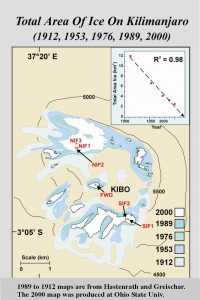
The linear extrapolation has an impressive R2 = 0.98 fit to the observations. However, a second-order polynomial fit gives a much better correlation (R2 = 0.997). While the linear extrapolation predicts the glaciers’ imminent disappearance, the polynomial extrapolation predicts that over the next decade the glaciers’ area should stabilize. The latest observation from Torbick et al. indicates that this may have already happened.
Hemingway’s fabled snows should survive to inspire many more generations of trekkers, and perhaps I’ll just have to go back there to enjoy them!




